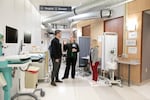Last week, Oregon Health & Science University received a warning sign about the rising transmission of COVID-19.
The hospital has four intensive care units. Three are specialty units that generally serve people coming out of surgery. The fourth is a medical ICU that serves everyone else.
Last week, more than half the patients in that 16-bed medical ICU were admitted for COVID-19 illness.
That was the trigger for the hospital to begin enacting the first steps of its COVID-19 contingency planning. The medical ICU has now been converted to a COVID-19-only unit.
“The volume we had — we had to trigger this last week, and we maintained it because of all these other indicating triggers that this is a climbing patient load,” says Dr. Matthias Merkel, the senior associate medical officer for capacity at OHSU.
One of the ripple effects for OHSU is that now, non-COVID patients are being sent to the hospital’s cardiovascular ICU instead of the medical ICU.

Hospital capacity and positive COVID-19 cases for 90% of hospital beds in Oregon are visible via a new data aggregation tool. The COVID Capacity Center is housed in OHSU's Mission Control Center.
Kristyna Wentz-Graff / (Photo courtesy OHSU)
It’s just one of many adjustments that Oregon hospitals are making — along with reducing elective surgeries and shifting some procedures to weekends — as they brace for a new wave of COVID-19 hospitalizations. That new wave is coming on top of the record number of patients previously admitted with the novel coronavirus.
Merkel says OHSU has reduced the number of elective surgeries, like knee replacements, that it has scheduled daily, and shifted some procedures to weekends, in an effort to make sure the hospital has enough staff and beds available at any given moment as the COVID wave hits.
With the fastest-growing number of COVID-19 cases on the West Coast, Oregon hospitals are preparing to deal with a surge in patients.
“When people become ill, we need to assure that there are enough hospital beds, PPE, and staff to prepare,” Brown said Tuesday at a media briefing. “This is very serious. Oregon is headed on the wrong road.”
When the first coronavirus case hit Oregon, hospitals started clearing out their intensive care unit beds and bracing for the kind of surge that was overwhelming hospitals from China to New York to Italy. Hospitals there and elsewhere were overflowing and doctors were making life-or-death decisions about how to best prioritize care.
That early surge never materialized in Oregon. COVID-19-related hospitalizations peaked at just over 300 patients, at which point cases were already declining as social-distancing measures had slowed the spread of the virus.
But as of Monday, there were 318 patients hospitalized with COVID-19, part of a pattern in which the number of new cases reported daily continues to climb.
“The trend is clear and very concerning,” said Dana Hargunani, the chief medical officer for the Oregon Health Authority.
While a case surge could be worse this time around, the state has had more time to prepare. Oregon’s warehouse is stocked with PPE — personal protective equipment: over 10 million surgical masks, nearly 4 million gowns and N95-masks and over 7 million gloves. New shipments of PPE are coming in every day: 5 million gloves arrived over the weekend.
Related: OPB's coronavirus coverage
And hospitals have had time to prepare, too. They’ve set up surge tents and additional beds in anticipation of a patient influx.
“We now have multiple plans and systems in place,” Hargunani said. “We’re better prepared than we were in February.”
Oregon Health & Science University’s triage center has been in use several times throughout the pandemic, mainly to help facilitate physical distancing when the emergency department overflows. It’s not currently in use, says OHSU spokesperson Erik Robinson, but it’s ready.
The state also organized hospitals into different regional groups to help share resources throughout different hospital networks. Each region has an appointed regional resource hospital.
“While we have plans in place to share beds and ventilators if necessary, that needs to be a last resort,” Brown said. “Lives are at stake.”
OHSU chief medical officer Renee Edwards said that some of those plans have been put into motion
“Last week in response to a record-breaking number of COVID-19 cases and a large increase in the number of critically ill patients requiring the highest level of nursing care, we had to crack open those plans and in some hospitals implement them in one or more of our intensive care units for the first time," Edwards said.
”We are at a crossroads," she said. The new cases found over the last week will lead to new hospitalizations in a few weeks. “It’s already baked in.”
Brown reminded Oregonians that the only way to avoid a hospital surge is for everyone to continue to practice social distancing, and try to limit gatherings to within their households, even if they aren’t in a county with a mandatory “pause” in response to rising cases.
‘All of this comes at a price’
OHSU is the regional resource center for northwestern Oregon. One of its designated regions, which runs from the Portland metro area to the coast, has seen the number of COVID-positive patients dramatically increase over the last few weeks.
OHSU’s Merkel says the hospital is ready for a surge. But Oregonians should still do everything they can to avoid one.

Left to right, Cory Woodyatt, R.N., Tonya Brockman, R.N., and Melinda Hartenstein, R.N., discuss protocols, March 24, 2020. The former OHSU auditorium space was converted to work as a routing area for people coming to the emergency department with respiratory symptoms that could be coronavirus-related. The area has intake, a waiting area that meets social distancing needs, triage and testing.
Kristyna Wentz-Graff
“We have a lot of resources and possibilities,” Merkel said. “But the key part in all of this is, the more we can avoid having infections, the better we will fare in the long run.”
Related: COVID-19 surge continues, ahead of Oregon’s partial ‘pause’ on gatherings
The simple fact is: as cases get higher, the quality of care will decline. “Yes, we have plans for how we can surge,” Merkel said, “But all of this comes at a price.”
At the press conference, hospital directors and public health officials repeatedly asked Oregonians to stay home and practice strict social distancing."When the pandemic started, we all got together with our teams to build these plans," said Dr. Jeff Absalon, the chief medical officer at St. Charles Health System, the largest healthcare provider in Central Oregon. He said those plans range from simple plans for a small increase to worst-case scenarios where people are sharing beds and resources.
“None of us wants to go there,” Absalon said.
Not just beds, but people
The number of beds available in any hospital is not fixed. Hospitals are large, and it’s not hard to find physical space and physical beds for patients.
“We can put beds in waiting rooms, we can put beds in conference rooms,” Absalon said. As of this week, his hospital system has as many critically ill COVID-19 patients as they did in the beginning of the pandemic.
But space isn’t what’s limiting his hospital’s capacity: it’s people.
“Staffing is really an issue as we bounce up against our capacity constraints,” Absalon said.
“We will have to reduce elective surgeries,” Absalon said. Many of those surgeries were rescheduled when elective procedures were paused across the state earlier this year.
Dr. Jamie Greboski is the chief medical officer at Asante, which runs four hospitals in Southern Oregon. Asante is a regional resource hospital in a part of Oregon that last week saw new diagnosed cases rise by 162%.That’s meant more hospitalizations, too. “Over the last few days, we’ve had a threefold increase in the number of patients,” Greboski said. He doesn’t see that slowing any time soon.
“We set up, regionally, a COVID hotline,” Greboski said. It can help people who think they have COVID figure out if they need to seek further care or go to a hospital.The line was flooded. “I heard today that we had 100 calls an hour in the first two hours of the day,” said Greboski.
There are patients at some of Asante’s hospitals that could be discharged to a different medical center to recover. That’s a common practice for patients recovering from a severe illness. But Greboski says the places they normally send patients - like memory care facilities, nursing homes, and skilled nursing facilities - either don’t have room, are already battling COVID-19 infections, or can’t accept any patients with COVID-19."At Medford Rogue (Regional Medical Center) we have 15 people waiting for a placement. In Grants Pass, ten people are waiting for a placement," Greboski said. That’s 25 fewer available beds available in the region until those patients can be moved.
A sickened workforce
Oregon currently still has enough nurses available statewide to care for COVID-19 patients and staff ICUs as they fill up, according to the Oregon Nurses Association.
“We still have enough nurses now,” said Kevin Mealy, a spokesperson for the union. “The number of beds is less important than the number of people able to staff them… there are interventions you can take to create more spaces, but creating people with the competency and training to care for patients is the much more important effort.”
Mealy said he’s most concerned about how rural hospitals will manage as the number of cases in Oregon hits a new peak.
“In areas of Oregon where there’s only one hospital for miles and miles and they begin with fewer ICU beds, it does not take a large outbreak to fill that capacity,” he said.
The nurses represented by the ONA remain extremely concerned about contracting COVID-19 on the job. According to Mealy, health care workers comprise about 10% of Oregon’s COVID-19 cases so far.
“We know that they are at a tremendous risk. That hasn’t changed, and it becomes more concerning as cases continue to rise,” he said.
Jennifer Burrows, the chief nursing officer at Providence echoed Mealy’s concerns. “We are seeing illness grow in our caregiver teams across the state.
”An outbreak can dramatically reduce hospitals' non-nursing staffing, too.
“That also has impact,” Burrows said. “Making sure there’s enough respiratory therapists to take care of patients, making sure there’s enough nurses, ensuring there’s enough providers.”
What’s more, according to Mealy, many policies that hospitals implemented at the outset of the pandemic to protect health care workers – like guaranteed, paid sick leave for shifts missed because of COVID-19 illness and employee access to testing – have expired or are set to expire at the end of the year.
The Providence hospital system’s agreements with nurses have expired, for example. At OHSU, contract negotiations between the nurses’ union and the hospital have stalled and COVID-19 protections, including access to PPE, are among the issues being negotiated.
Several days after this article posted, OPB reporter Amelia Templeton discussed the challenges hospitals are facing with “All Things Considered” host Tiffany Camhi. Click play below to listen to the conversation.

